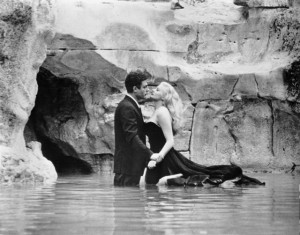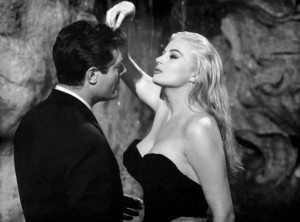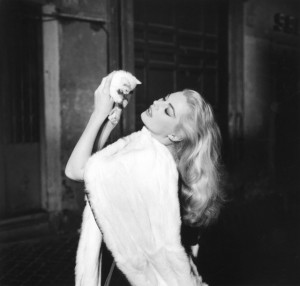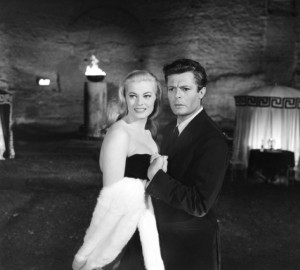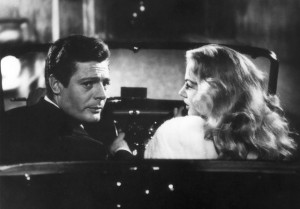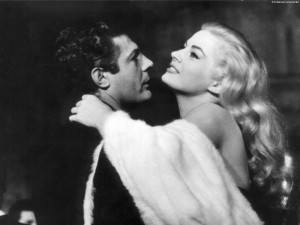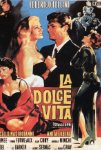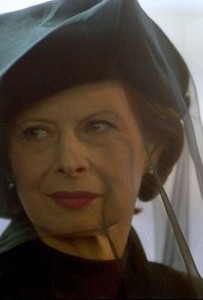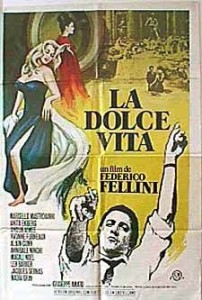La Dolce Vita ***** (1960, Marcello Mastroianni, Anita Ekberg, Anouk Aimee, Yvonne Furneaux, Magali Noël, Alain Cuny, Lex Barker, Nadia Gray) – Classic Movie Review 628
Co-writer/director Federico Fellini infamously dissects the decadent life of Rome in 1960, a world populated by cynical journalists and dissolute, disillusioned people like bored socialite Maddalena (Anouk Aimée), sexpot film star Sylvia (Anita Ekberg) and strip-teasing countess Nadia (Nadia Gray).
Fellini’s alter ego is Marcello Mastroianni, charismatically playing Marcello Rubini, a world-weary journalist and man-about-town who revels in the sweet life of easy sex and easy money. Torn between the Italian capital’s elite social scene and his girlfriend’s stifling domesticity, he struggles to find his niche, while trying to become a serious writer. By the end of the film, he finally gets tired of la dolce vita. He’s had enough, particularly disgusted at the climactic orgy that gave the film its notoriety in 1960.
Fellini’s film is a walk on the wild side, achieved with high gloss, much wit and great style, with extraordinary music and cinematography. The film showcases some of cinema’s most unforgettable images, particularly the famous flying Christ statue over St Peter’s, Ekberg’s even more famous splash in the Trevi Fountain (Fontana di Trevi) and the giant dead fish washed up on the beach.
This is entertaining, almost tabloid cake-and-eat-it exposé stuff. Fellini delights in displaying the decadence of Rome while he quietly, cynically tuts-tuts in the background, thoroughly enjoying and indulging himself. He isn’t giving much away, though. What’s his real attitude to the threesome between Mastroianni’s character, a nymphomaniac socialite (Anouk Aimée) and a hooker? What’s he thinking about when he gets statuesque Rumanian Nadia Gray to do a strip? How does he truly feel about the infamous final orgy?
Of course times change and such once shocking sexual shenanigans are now commonplace in the cinema. But they still have the power to stir through Fellini’s imagination, intelligence and flair in handling the scenes and his characters. Technically, too, it impresses. Otello Martelli’s black and white images are always striking and occasionally astounding, while the music by another Fellini regular, Nino Rota, has a rare vitality, reflecting Rome’s own. Piero Gherardi’s art direction and set decoration and his Oscar-winning black and white costumes are a total eyeful, too.
Best film Palme d’Or winner at the Cannes film Festival in 1960, it was condemned by the Italian Catholic party Democrazia Cristiana and the Vatican.
Fellini contributed the word ‘paparazzo’ to the language. The term derives from Marcello’s photographer friend Paparazzo, the name from the name of someone Fellini met in Calabria. Paparazzo is played by Walter Santesso. ‘Paparazzo’ means ‘sparrow’ in one Italian dialect and Fellini said the photographers hopping and scurrying around celebrities reminded him of sparrows.
Dino De Laurentiis quit as producer when Fellini refused to cast Paul Newman or Gérard Philipe in the lead and insisted on Mastroianni. De Laurentiis thought he was ‘too soft and goody-goody, a family man rather than the type who flings women onto the bed.’
The Trevi Fountain scene was shot in March, when nights were still cold. According to Federico Fellini, Ekberg stood in the cold water in her dress for hours without any trouble but Mastroianni had to wear a wetsuit beneath his clothes and got drunk on vodka. They put green dye in the water to make it look clean. It was an airline’s green sea dye marker for use in case of an emergency landing at sea.
The favourite movie of Roger Ebert, who saw it over 25 times.
Anita Ekberg died on 11 January 2015 in Rocca di Papa, near Rome, aged 83.
The sexy Turkish-born actress Magali Noël (born Magali Giuffra) died on June 23 2015, aged 82. She appeared primarily in French and Italian productions and was notable as an object of desire in the Fellini masterpieces La Dolce Vita, Satyricon (1969) and Amarcord (1973).
© Derek Winnert 2014 Classic Movie Review 628
Check out more reviews on http://derekwinnert.com/



